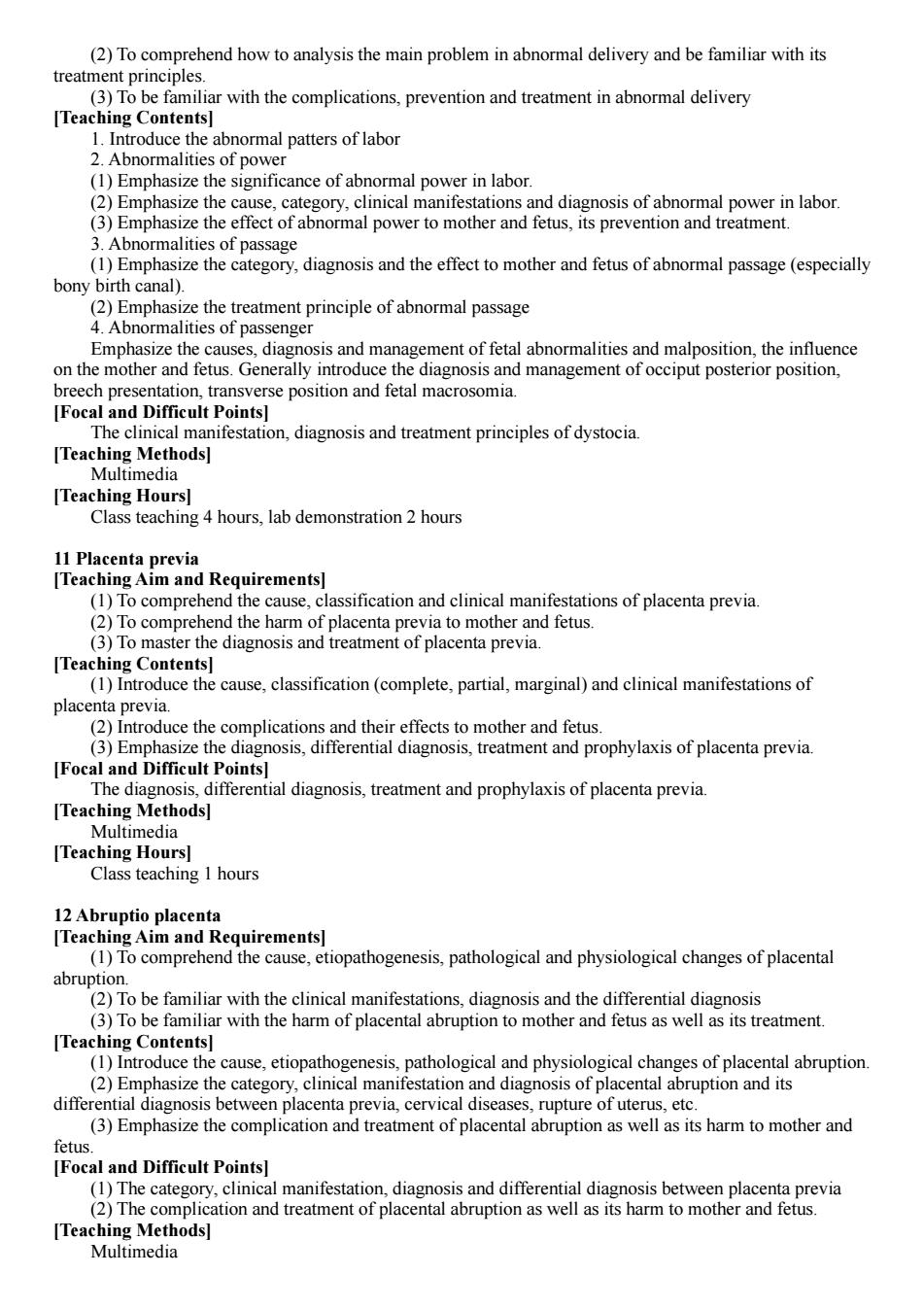
(2)To comprehend how to analysis the main problem in abnormal delivery and be familiar with its treatment principles. ng Conte ne at normal patters of labo (1)Emphasize the significance of abnormal power in labor. (2)Emphasize the cause.categ ry.clinical manifestations and diagnosis of abnormal power in labor. (3)Emphasize the effect of abnormal power to mother and fetus,its prevention and treatment. 3.Abnormalities of passage (1)Emphasize the category.diagnosis and the effect to mother and fetus of abnormal passage (especially bony birth canal) (2) siethe treatment principle of abnormal passage s and m tgementofocipulposileriorposition, preech presentation.transverse position and fetal macrosomia. [Focal and Difficult Points] The clinical manifestation,diagnosis and treatment principles of dystocia. [Teaching Methods] Multin edia 4boulabdmonou 11 Placenta previa [Teaching Aim and Requirements] (1)To comprehend the cause,classification and clinical manifestations of placenta previa. (2)To comprehend the harm of placenta previa to mother and fetus. (3)To master the diagnosis and treatment of placenta previa. [Teaching Contents] uce the cause,classification(complete,partial,marginal)and clinical manifestations of nd fet [Focal and Difficult Points] and prophylaxis of placenta previa The diagnosis,differential diagnosis,treatment and prophylaxis of placenta previa. [Teaching Methods] Multimedia [Teaching Hours] Class teaching 1 hours 12 Abruptio placenta [Teachin Ain use,etiopathogenesis,pathological and physiological changes of placental abruption. (2)To be familiar with the clinical manifestations,diagnosis and the differential diagnosis (3)To be familiar with the harm of placental abruption to mother and fetus as well as its treatment. [Teaching Contents] and physiologica omanddagnos ental abruption oI p ental a diffe (3)Emphasize the well as its harm to mother and fetus [Focal and Difficult Points] (1)The category,clinical manifestation,diagnosis and differential diagnosis between placenta previa (2)The complication and treatment of placental abruption as well as its harm to mother and fetus. [Teaching Methods] Multimedia
(2) To comprehend how to analysis the main problem in abnormal delivery and be familiar with its treatment principles. (3) To be familiar with the complications, prevention and treatment in abnormal delivery [Teaching Contents] 1. Introduce the abnormal patters of labor 2. Abnormalities of power (1) Emphasize the significance of abnormal power in labor. (2) Emphasize the cause, category, clinical manifestations and diagnosis of abnormal power in labor. (3) Emphasize the effect of abnormal power to mother and fetus, its prevention and treatment. 3. Abnormalities of passage (1) Emphasize the category, diagnosis and the effect to mother and fetus of abnormal passage (especially bony birth canal). (2) Emphasize the treatment principle of abnormal passage 4. Abnormalities of passenger Emphasize the causes, diagnosis and management of fetal abnormalities and malposition, the influence on the mother and fetus. Generally introduce the diagnosis and management of occiput posterior position, breech presentation, transverse position and fetal macrosomia. [Focal and Difficult Points] The clinical manifestation, diagnosis and treatment principles of dystocia. [Teaching Methods] Multimedia [Teaching Hours] Class teaching 4 hours, lab demonstration 2 hours 11 Placenta previa [Teaching Aim and Requirements] (1) To comprehend the cause, classification and clinical manifestations of placenta previa. (2) To comprehend the harm of placenta previa to mother and fetus. (3) To master the diagnosis and treatment of placenta previa. [Teaching Contents] (1) Introduce the cause, classification (complete, partial, marginal) and clinical manifestations of placenta previa. (2) Introduce the complications and their effects to mother and fetus. (3) Emphasize the diagnosis, differential diagnosis, treatment and prophylaxis of placenta previa. [Focal and Difficult Points] The diagnosis, differential diagnosis, treatment and prophylaxis of placenta previa. [Teaching Methods] Multimedia [Teaching Hours] Class teaching 1 hours 12 Abruptio placenta [Teaching Aim and Requirements] (1) To comprehend the cause, etiopathogenesis, pathological and physiological changes of placental abruption. (2) To be familiar with the clinical manifestations, diagnosis and the differential diagnosis (3) To be familiar with the harm of placental abruption to mother and fetus as well as its treatment. [Teaching Contents] (1) Introduce the cause, etiopathogenesis, pathological and physiological changes of placental abruption. (2) Emphasize the category, clinical manifestation and diagnosis of placental abruption and its differential diagnosis between placenta previa, cervical diseases, rupture of uterus, etc. (3) Emphasize the complication and treatment of placental abruption as well as its harm to mother and fetus. [Focal and Difficult Points] (1) The category, clinical manifestation, diagnosis and differential diagnosis between placenta previa (2) The complication and treatment of placental abruption as well as its harm to mother and fetus. [Teaching Methods] Multimedia
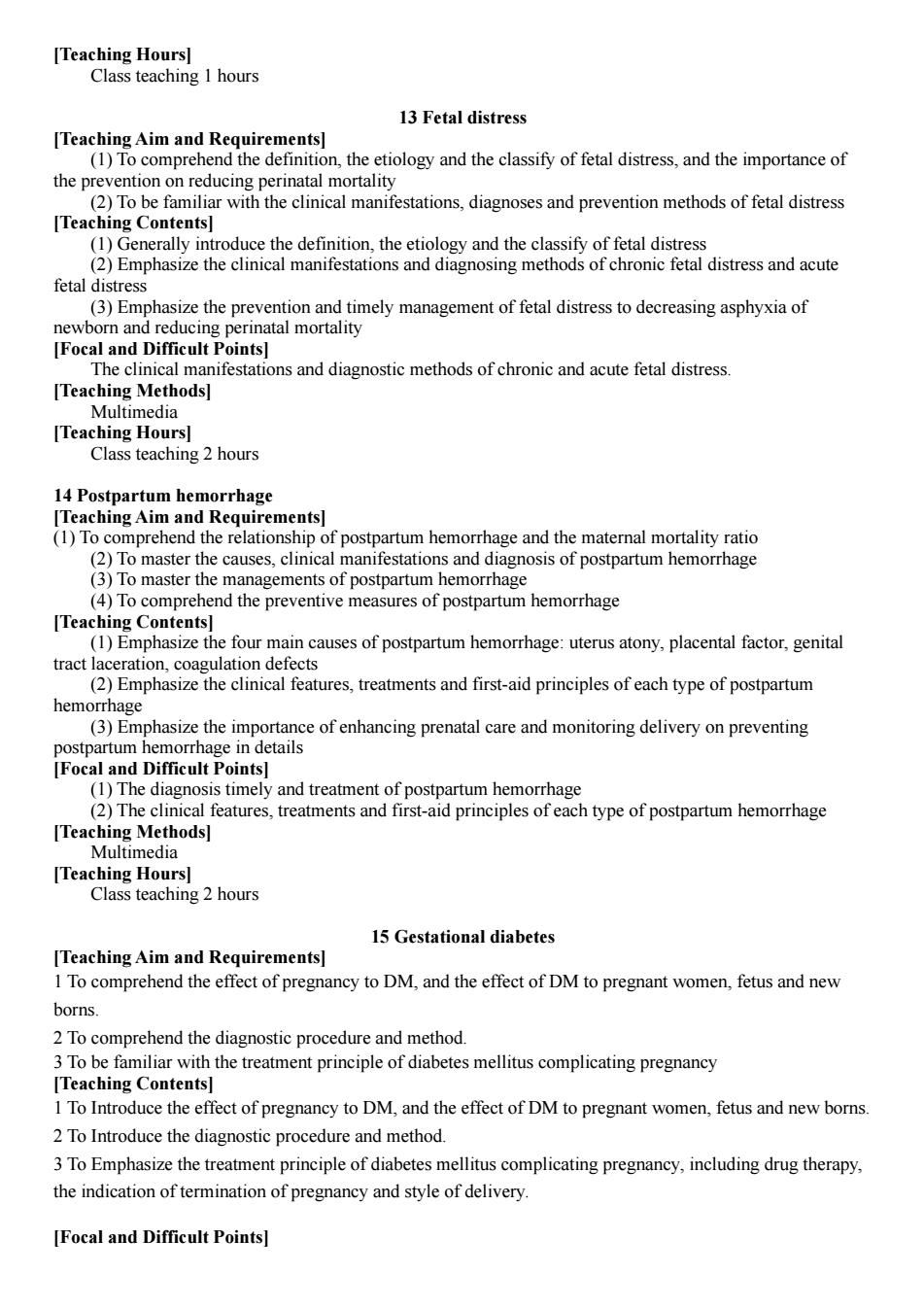
Teaching Hours] Class teaching I hours 13 Fetal distress [Teaching Aim and Re (1)To co mprehend the the tioloy and the classify of fetal distress,and the importance of the prevention on reducing pe rinatal mortality (2)To be familiar with the clinical manifestations,diagnoses and prevention methods of fetal distress [Teaching Contents] (1)Generally introduce the definition,the etiology and the classify of fetal distress hastz the ccal manitestations and diagnosing methods of chronic fetal distress an nd timely management of fetal distress to decreasing asphyxia of Focal and Difficult Points] The clinical manifestations and diagnostic methods of chronic and acute fetal distress. [Teaching Methods] Multimedia [Teaching Hours] Class teaching 2 hours 14 Postpartum he rrhage (m nts nd th f postpartum hemorrhage and the maternal mortality ratio (2)To master the causes.clinical manifestations and diagnosis of po stpartum hemorrhage (3)To master the managements of postpartum hemorrhage (4)To comprehend the preventive measures of postpartum hemorrhage [Teaching Contents] (1)Emphasize the four main causes of postpartum hemorrhage:uterus atony,placental factor,genita tract hem )Emphasize the im ortance of enhancing prenatal care and monitoring delivery on preventing Focal amd Dimc rtum hemorrhage in details (1)The diagnosis timely and treatment of postpartum hemorrhage (2)The clinical features,treatments and first-aid principles of each type of postpartum hemorrhage [Teaching Methods] m edia hing 2 hours 15 Gestational diabetes [Teaching Aim and Requirements] 1 To comprehend the effect of pregnancy to DM,and the effect of DM to pregnant women,fetus and new borns. ostic pro and method th the treatment principle of diabetes mellitus complicating pregnancy Contents thffct of pre o DM.and the efect of DMtoprm.fusm 2To Introduce the diagnostic procedure and method. 3 To Emphasize the treatment principle of diabetes mellitus complicating pregnancy,including drug therapy, the indication of termination of pregnancy and style of delivery. [Focal and Difficult Points]
[Teaching Hours] Class teaching 1 hours 13 Fetal distress [Teaching Aim and Requirements] (1) To comprehend the definition, the etiology and the classify of fetal distress, and the importance of the prevention on reducing perinatal mortality (2) To be familiar with the clinical manifestations, diagnoses and prevention methods of fetal distress [Teaching Contents] (1) Generally introduce the definition, the etiology and the classify of fetal distress (2) Emphasize the clinical manifestations and diagnosing methods of chronic fetal distress and acute fetal distress (3) Emphasize the prevention and timely management of fetal distress to decreasing asphyxia of newborn and reducing perinatal mortality [Focal and Difficult Points] The clinical manifestations and diagnostic methods of chronic and acute fetal distress. [Teaching Methods] Multimedia [Teaching Hours] Class teaching 2 hours 14 Postpartum hemorrhage [Teaching Aim and Requirements] (1) To comprehend the relationship of postpartum hemorrhage and the maternal mortality ratio (2) To master the causes, clinical manifestations and diagnosis of postpartum hemorrhage (3) To master the managements of postpartum hemorrhage (4) To comprehend the preventive measures of postpartum hemorrhage [Teaching Contents] (1) Emphasize the four main causes of postpartum hemorrhage: uterus atony, placental factor, genital tract laceration, coagulation defects (2) Emphasize the clinical features, treatments and first-aid principles of each type of postpartum hemorrhage (3) Emphasize the importance of enhancing prenatal care and monitoring delivery on preventing postpartum hemorrhage in details [Focal and Difficult Points] (1) The diagnosis timely and treatment of postpartum hemorrhage (2) The clinical features, treatments and first-aid principles of each type of postpartum hemorrhage [Teaching Methods] Multimedia [Teaching Hours] Class teaching 2 hours 15 Gestational diabetes [Teaching Aim and Requirements] 1 To comprehend the effect of pregnancy to DM, and the effect of DM to pregnant women, fetus and new borns. 2 To comprehend the diagnostic procedure and method. 3 To be familiar with the treatment principle of diabetes mellitus complicating pregnancy [Teaching Contents] 1 To Introduce the effect of pregnancy to DM, and the effect of DM to pregnant women, fetus and new borns. 2 To Introduce the diagnostic procedure and method. 3 To Emphasize the treatment principle of diabetes mellitus complicating pregnancy, including drug therapy, the indication of termination of pregnancy and style of delivery. [Focal and Difficult Points]
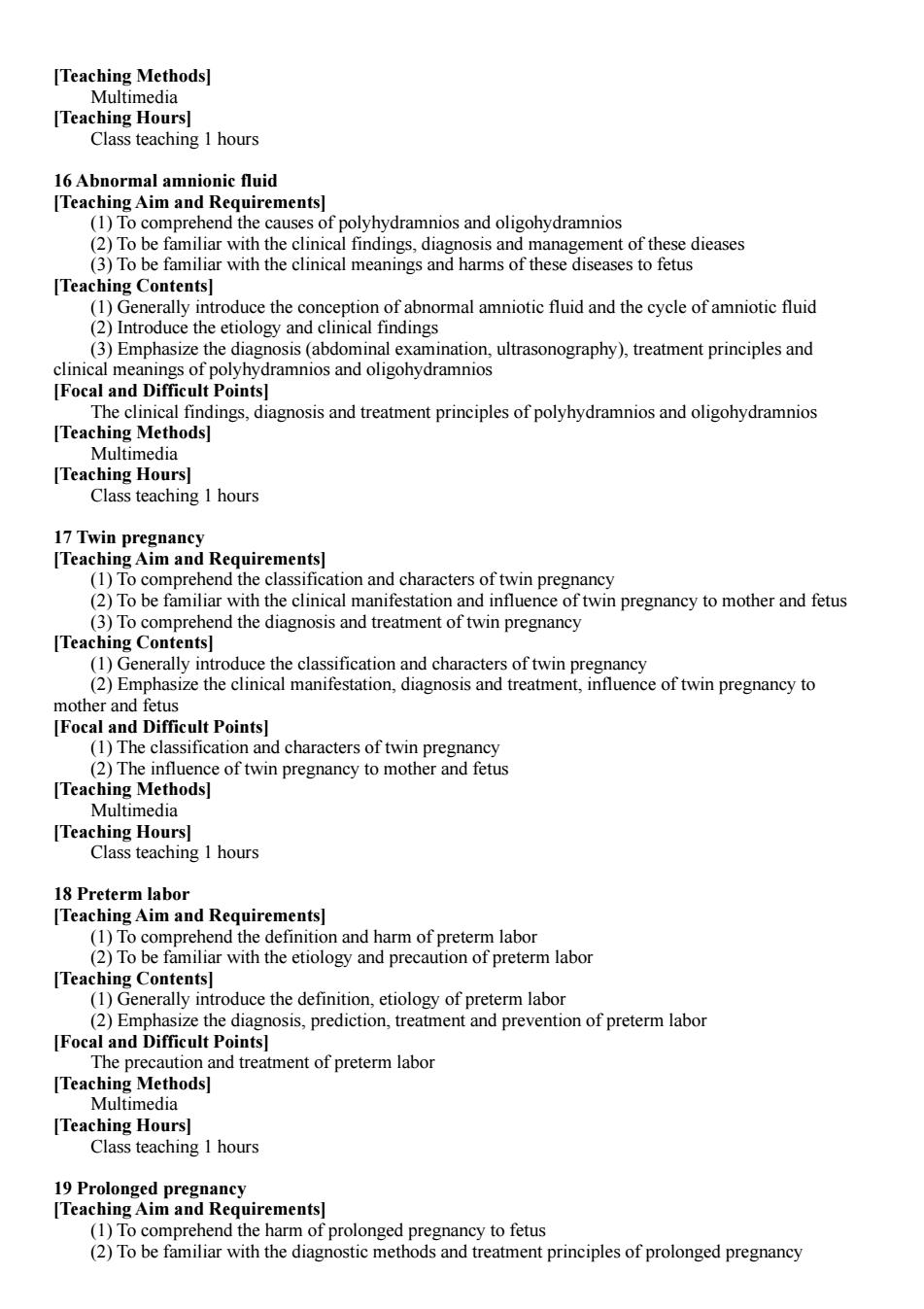
[Teaching Methods] ning 1 hours 16 Abnormal amnionic fluid ITeaching aim and requirementsl (1)To comprehend the causes of polyhydramnios and oligohydramnios (2)To be familiar with the clinical findings,diagnosis and management of these dieases (3)To be familiar with the clinical meanings and harms of these diseases to fetus [Teaching Contents] l amniot fuid and the cycle of miotl 3) clinical meanings of polyhydramnios and nation,ultrasonography),treatment principles and [Focal and Difficult Points] The clinical findings,diagnosis and treatment principles of polyhydramnios and oligohydramnios [Teaching Methods] Multimedia [Teaching Hours Class teaching I hours (the classification and characters of twin pregnancy (2)To be familiar with the clinical manifestation and influence of twin pregnancy to mother and fetus (3)To comprehend the diagnosis and treatment of twin pregnancy [Teaching Contents] nd pha size the clinical mar estation,diagnosis and treatment,influence of twin pregnancy to (1)The classification and characters of twin pregnancy The influence of twin preg ancy to mother and fetus [Teaching Methods] Multimedia [Teaching Hours] Class teaching 1 hours 18 Preterm labor ()Tocomprehend the definition and ha /11 n and harm of [Teaching Contents] (1)Generally introduce the definition,etiology of preterm labor (2)Emphasize the diagnosis,prediction,treatment and prevention of preterm labor [Focal and Difficult Points] [Teach [Teaching Ho Class teaching 1 hours 19 Prolonged pregnancy [Teaching Aim and Requirements] (1)To comprehend the harm of prolonged pregnancy to fetus (2)To be familiar with the diagnostic methods and treatment principles of prolonged pregnancy
[Teaching Methods] Multimedia [Teaching Hours] Class teaching 1 hours 16 Abnormal amnionic fluid [Teaching Aim and Requirements] (1) To comprehend the causes of polyhydramnios and oligohydramnios (2) To be familiar with the clinical findings, diagnosis and management of these dieases (3) To be familiar with the clinical meanings and harms of these diseases to fetus [Teaching Contents] (1) Generally introduce the conception of abnormal amniotic fluid and the cycle of amniotic fluid (2) Introduce the etiology and clinical findings (3) Emphasize the diagnosis (abdominal examination, ultrasonography), treatment principles and clinical meanings of polyhydramnios and oligohydramnios [Focal and Difficult Points] The clinical findings, diagnosis and treatment principles of polyhydramnios and oligohydramnios [Teaching Methods] Multimedia [Teaching Hours] Class teaching 1 hours 17 Twin pregnancy [Teaching Aim and Requirements] (1) To comprehend the classification and characters of twin pregnancy (2) To be familiar with the clinical manifestation and influence of twin pregnancy to mother and fetus (3) To comprehend the diagnosis and treatment of twin pregnancy [Teaching Contents] (1) Generally introduce the classification and characters of twin pregnancy (2) Emphasize the clinical manifestation, diagnosis and treatment, influence of twin pregnancy to mother and fetus [Focal and Difficult Points] (1) The classification and characters of twin pregnancy (2) The influence of twin pregnancy to mother and fetus [Teaching Methods] Multimedia [Teaching Hours] Class teaching 1 hours 18 Preterm labor [Teaching Aim and Requirements] (1) To comprehend the definition and harm of preterm labor (2) To be familiar with the etiology and precaution of preterm labor [Teaching Contents] (1) Generally introduce the definition, etiology of preterm labor (2) Emphasize the diagnosis, prediction, treatment and prevention of preterm labor [Focal and Difficult Points] The precaution and treatment of preterm labor [Teaching Methods] Multimedia [Teaching Hours] Class teaching 1 hours 19 Prolonged pregnancy [Teaching Aim and Requirements] (1) To comprehend the harm of prolonged pregnancy to fetus (2) To be familiar with the diagnostic methods and treatment principles of prolonged pregnancy
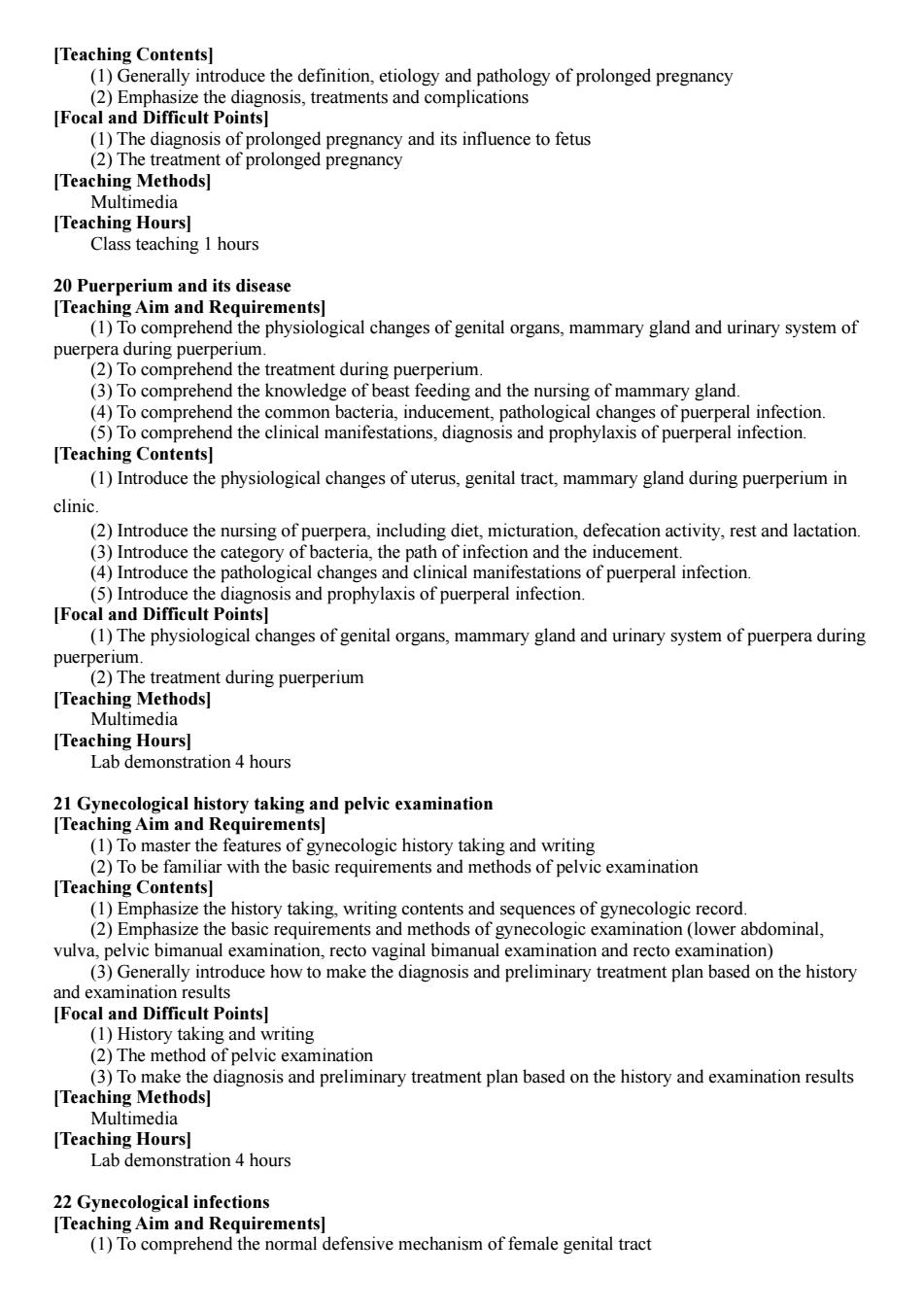
ITeaching Contents] Epe the definition,etiology and pathology of prolonged pregnancy sis,treatments and complications (T and its influence to fetus [Teaching Methods] Multimedia [Teaching Hours] Class teaching 1 hours erpe 20 Pu and its disease [Tea Aim ogical changes of genital organs,mammary gland and urinary system of durin erium (3)To comprehend the knowledge of beast feeding and the nursing of mammary gland. (4)To comprehend the common bacteria,inducement,pathological changes of puerperal infection. (5)To comprehend the clinical manifestations,diagnosis and prophylaxis of puerperal infection. [Teaching Contents] (1)Introduce the physiological changes of uterus,genital tract,mammary gland during puerperium in clinic he ca acteria,the pat (5)Introdu e a and prophyla is of puerpe al i [Focal and Difficult Points] (1)The physiological changes of genital organs,mammary gland and urinary system of puerpera during puerperium (2)The treatment during puerperium [Teaching Methods] Teachi edia ion 4 hours 21 Gynecological history taking and pelvic examination [Teaching Aim and Requirements] (1)To master the features of gynecologic history taking and writing (2)To be familiar with the basic requirements and methods of pelvic examination [Teaching Contents] the basic requiren ents and me tion(lower abdominal. vulv nd preliminary treatment plan ba n the history and examination results [Focal and Difficult Points] (1)History taking and writing (2)The method of pelvic examination (3)To make the diagnosis and preliminary treatment plan based on the history and examination results [Teaching Methods] ation 4 hours 22 Gynecological infections [Teaching Aim and Requirements] (1)To comprehend the normal defensive mechanism of female genital tract
[Teaching Contents] (1) Generally introduce the definition, etiology and pathology of prolonged pregnancy (2) Emphasize the diagnosis, treatments and complications [Focal and Difficult Points] (1) The diagnosis of prolonged pregnancy and its influence to fetus (2) The treatment of prolonged pregnancy [Teaching Methods] Multimedia [Teaching Hours] Class teaching 1 hours 20 Puerperium and its disease [Teaching Aim and Requirements] (1) To comprehend the physiological changes of genital organs, mammary gland and urinary system of puerpera during puerperium. (2) To comprehend the treatment during puerperium. (3) To comprehend the knowledge of beast feeding and the nursing of mammary gland. (4) To comprehend the common bacteria, inducement, pathological changes of puerperal infection. (5) To comprehend the clinical manifestations, diagnosis and prophylaxis of puerperal infection. [Teaching Contents] (1) Introduce the physiological changes of uterus, genital tract, mammary gland during puerperium in clinic. (2) Introduce the nursing of puerpera, including diet, micturation, defecation activity, rest and lactation. (3) Introduce the category of bacteria, the path of infection and the inducement. (4) Introduce the pathological changes and clinical manifestations of puerperal infection. (5) Introduce the diagnosis and prophylaxis of puerperal infection. [Focal and Difficult Points] (1) The physiological changes of genital organs, mammary gland and urinary system of puerpera during puerperium. (2) The treatment during puerperium [Teaching Methods] Multimedia [Teaching Hours] Lab demonstration 4 hours 21 Gynecological history taking and pelvic examination [Teaching Aim and Requirements] (1) To master the features of gynecologic history taking and writing (2) To be familiar with the basic requirements and methods of pelvic examination [Teaching Contents] (1) Emphasize the history taking, writing contents and sequences of gynecologic record. (2) Emphasize the basic requirements and methods of gynecologic examination (lower abdominal, vulva, pelvic bimanual examination, recto vaginal bimanual examination and recto examination) (3) Generally introduce how to make the diagnosis and preliminary treatment plan based on the history and examination results [Focal and Difficult Points] (1) History taking and writing (2) The method of pelvic examination (3) To make the diagnosis and preliminary treatment plan based on the history and examination results [Teaching Methods] Multimedia [Teaching Hours] Lab demonstration 4 hours 22 Gynecological infections [Teaching Aim and Requirements] (1) To comprehend the normal defensive mechanism of female genital tract
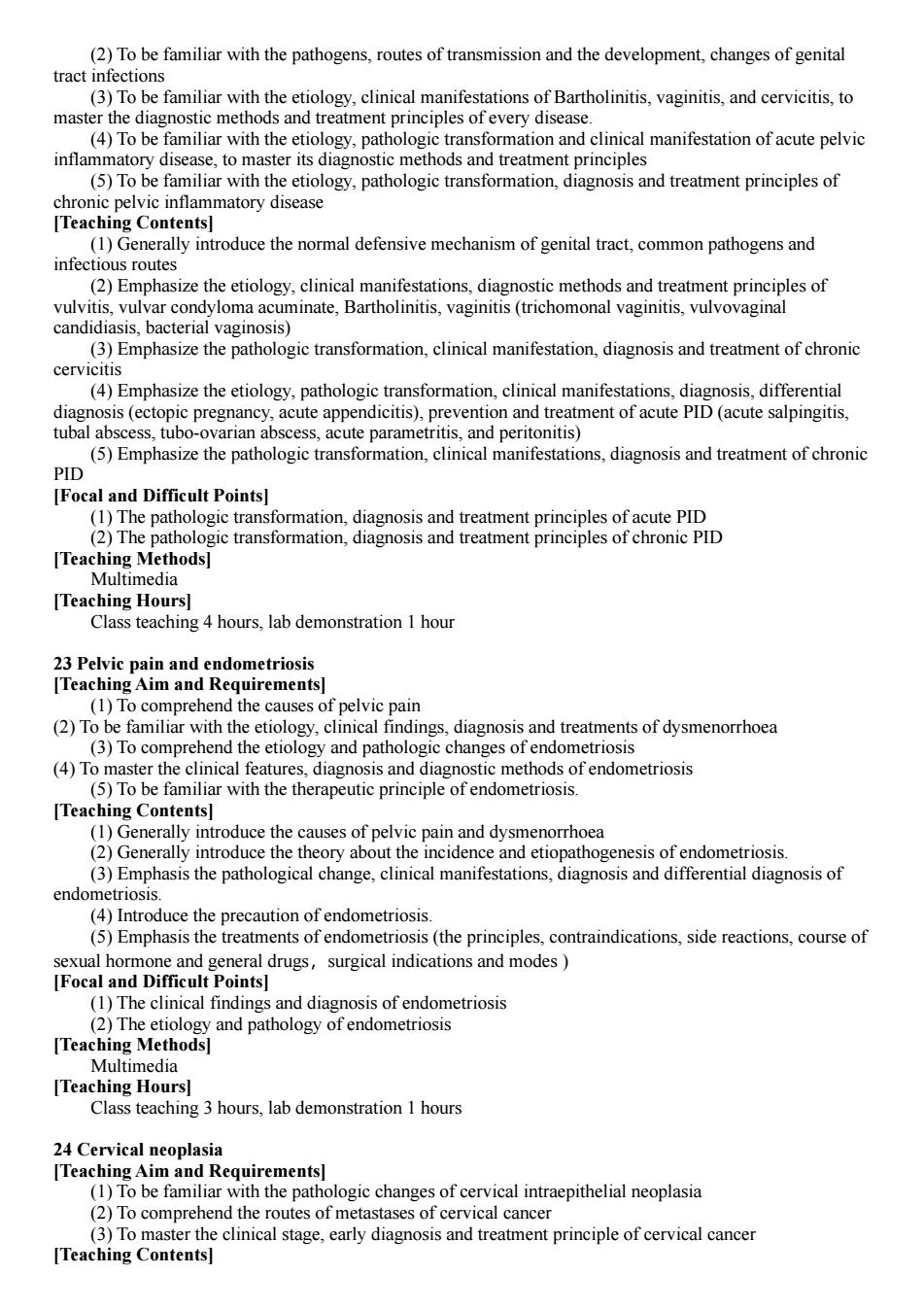
(2)To be familiar with the pathogens.routes of transmission and the development.changes of genital tract infections (3)To be familiar with the etiology,clinical manifestations of Bartholinitis,vaginitis,and cervicitis,to maste the tment prin les of every diseas dis to gy,patn tho nd tr (5)To be familiar with the etiology,pathologie transforr mat diagno osis and treatment principles of chronic pelvic inflammatory disease [Teaching Contents] (1)Generally introduce the normal defensive mechanism of genital tract common pathogens and infectious routes ()Emphasize the tioloy,methods and treatment principles of dyloma acuminate,Bartholinitis,vaginitis (trichomonal vaginitis,vulvovagina Empha the P ologic transformation,clinical manifestation,diagnosis and treatment of chronic cervicitis (4)Emphasize the etiology.pathologic transformation clinical manifestations.diagnosis.differential diagnosis(ectopic pregnancy,acute appendicitis),prevention and treatment of acute PID(acute salpingitis, tubal abscess,tubo-ovarian abscess,acute parametritis,and peritonitis) (5)Emphasize the pathologic transformation.clinical manifestations.diagnosis and treatment of chronic PID Focal and Difficult Points e pa PID [Teaching Methods] Multimedia [Teaching Hours] Class teaching 4 hours lab demonstration i hour ing Aim an comprehe the cau s of an rea (3)To com rehend the nd r h (4)To master the clinical feature nosis and diag stic methods of endometriosis (5)To be familiar with the therapeutic principle of endometriosis. [Teaching Contents] (1)Generally introduce the causes of pelvic pain and dysmenorrhoea (2)Generally introduce the theory about the incidence and etiopathogenesis of endometriosis (mphasisth (4)Int phasis the prec duce the 5)Em riosis(the principl s,contraindications,side reactions,course of rugs,surgical indications and modes) and diagnosis of endometriosis (2)The etiology and pathology of endometriosis [Teaching Methods] Multimedia [Teaching Hours] Class teaching 3 hours,lab demonstration I hours 24 Cervical neoplasis (To be ilia with the pathologic changes s of cervical intraepithelial neoplasia (2)To com orehend the outes of m etastases of cer vical cancer (3)To master the clinical stage.early diagnosis and treatment principle of cervical cancer [Teaching Contents]
(2) To be familiar with the pathogens, routes of transmission and the development, changes of genital tract infections (3) To be familiar with the etiology, clinical manifestations of Bartholinitis, vaginitis, and cervicitis, to master the diagnostic methods and treatment principles of every disease. (4) To be familiar with the etiology, pathologic transformation and clinical manifestation of acute pelvic inflammatory disease, to master its diagnostic methods and treatment principles (5) To be familiar with the etiology, pathologic transformation, diagnosis and treatment principles of chronic pelvic inflammatory disease [Teaching Contents] (1) Generally introduce the normal defensive mechanism of genital tract, common pathogens and infectious routes (2) Emphasize the etiology, clinical manifestations, diagnostic methods and treatment principles of vulvitis, vulvar condyloma acuminate, Bartholinitis, vaginitis (trichomonal vaginitis, vulvovaginal candidiasis, bacterial vaginosis) (3) Emphasize the pathologic transformation, clinical manifestation, diagnosis and treatment of chronic cervicitis (4) Emphasize the etiology, pathologic transformation, clinical manifestations, diagnosis, differential diagnosis (ectopic pregnancy, acute appendicitis), prevention and treatment of acute PID (acute salpingitis, tubal abscess, tubo-ovarian abscess, acute parametritis, and peritonitis) (5) Emphasize the pathologic transformation, clinical manifestations, diagnosis and treatment of chronic PID [Focal and Difficult Points] (1) The pathologic transformation, diagnosis and treatment principles of acute PID (2) The pathologic transformation, diagnosis and treatment principles of chronic PID [Teaching Methods] Multimedia [Teaching Hours] Class teaching 4 hours, lab demonstration 1 hour 23 Pelvic pain and endometriosis [Teaching Aim and Requirements] (1) To comprehend the causes of pelvic pain (2) To be familiar with the etiology, clinical findings, diagnosis and treatments of dysmenorrhoea (3) To comprehend the etiology and pathologic changes of endometriosis (4) To master the clinical features, diagnosis and diagnostic methods of endometriosis (5) To be familiar with the therapeutic principle of endometriosis. [Teaching Contents] (1) Generally introduce the causes of pelvic pain and dysmenorrhoea (2) Generally introduce the theory about the incidence and etiopathogenesis of endometriosis. (3) Emphasis the pathological change, clinical manifestations, diagnosis and differential diagnosis of endometriosis. (4) Introduce the precaution of endometriosis. (5) Emphasis the treatments of endometriosis (the principles, contraindications, side reactions, course of sexual hormone and general drugs,surgical indications and modes ) [Focal and Difficult Points] (1) The clinical findings and diagnosis of endometriosis (2) The etiology and pathology of endometriosis [Teaching Methods] Multimedia [Teaching Hours] Class teaching 3 hours, lab demonstration 1 hours 24 Cervical neoplasia [Teaching Aim and Requirements] (1) To be familiar with the pathologic changes of cervical intraepithelial neoplasia (2) To comprehend the routes of metastases of cervical cancer (3) To master the clinical stage, early diagnosis and treatment principle of cervical cancer [Teaching Contents]